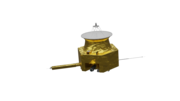Exploration of Neptune
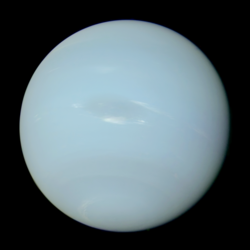
Neptune has been directly explored by one space probe, Voyager 2, in 1989. As of 2024[update], there are no confirmed future missions to visit the Neptunian system, although a tentative Chinese mission has been planned for launch.[1] NASA, ESA, and independent academic groups have proposed future scientific missions to visit Neptune. Some mission plans are still active, while others have been abandoned or put on hold.[citation needed]
Since the mid-1990s, Neptune has been studied from afar with telescopes, including the Hubble Space Telescope and the ground-based Keck telescope using adaptive optics.[2]
Voyager 2
[edit]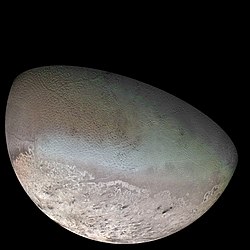
After Voyager 2 visited Saturn successfully, it was decided to fund further missions to Uranus and Neptune. These missions were conducted by the Jet Propulsion Laboratory, and the Neptunian mission was dubbed "Voyager Neptune Interstellar Mission". Voyager 2 started taking navigation images of Neptune in May 1988.[3] Voyager 2's observation phase proper of Neptune began 5 June 1989, the spacecraft officially reached the Neptunian system on 25 August, and data collection ceased on 2 October.[4] Initially it was planned to use a trajectory that resulted in Voyager 2 passing around 1,300 km (810 mi) from Neptune and 8,200 km (5,100 mi) from Triton.[5] The need to avoid ring material detected by stellar occultations prompted this trajectory to be abandoned, and a trajectory that largely avoided the rings but resulted in more distant flybys of both targets was plotted.[5]
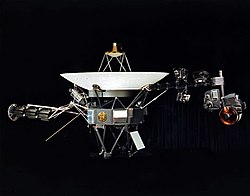
On 25 August, in Voyager 2's last planetary encounter, the spacecraft swooped only 4,950 km (3,080 mi) above Neptune's north pole, the closest approach it had made to any body since it left Earth in 1977. At that time, Neptune was the farthest known body in the Solar System. It would not be until 1999 that Pluto would move further from the Sun in its trajectory. Voyager 2 studied Neptune's atmosphere, Neptune's rings, its magnetosphere, and Neptune's moons.[6] The Neptunian system had been studied scientifically for many years with telescopes and indirect methods, but the close inspection by the Voyager 2 probe settled many issues[example needed] and revealed a plethora of information that could not have been obtained otherwise.[example needed] The data from Voyager 2 are still the best data available on this planet in most cases.[citation needed]
The exploration mission revealed that Neptune's atmosphere is very dynamic, even though it receives only three percent of the sunlight that Jupiter receives. Winds on Neptune were found to be the strongest in the Solar System, up to three times stronger than Jupiter's and nine times stronger than the strongest winds on Earth. Most winds blew westward, opposite the planet's rotation. Separate cloud decks were discovered, with cloud systems emerging and dissolving within hours and giant storms circling the entire planet within sixteen to eighteen hours in the upper layers. Voyager 2 discovered an anticyclone dubbed the Great Dark Spot, similar to Jupiter's Great Red Spot. However, images taken by the Hubble Space Telescope in 1994 revealed that the Great Dark Spot had disappeared.[7] Also seen in Neptune's upper atmosphere was an almond-shaped spot designated D2 and a bright, quickly moving cloud high above the cloud decks dubbed "Scooter".[4][8]
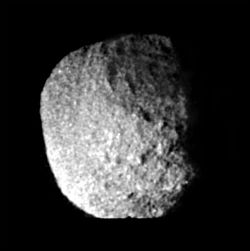
The fly-by of the Neptunian system provided the first accurate measurement of Neptune's mass, which was found to be 0.5 percent less than previously calculated. The new figure disproved the hypothesis that an undiscovered Planet X acted upon the orbits of Neptune and Uranus.[9][10]
Neptune's magnetic field was found to be highly tilted and largely offset from the planet's centre. The probe discovered auroras much weaker than those on Earth or other planets. The radio instruments on board found that Neptune's day lasts 16 hours and 6.7 minutes. Neptune's rings had been observed from Earth many years prior to Voyager 2's visit, but the close inspection revealed that the ring systems were full circle and intact, and a total of four rings were counted.[4]
Voyager 2 discovered six new small moons orbiting Neptune's equatorial plane, dubbed Naiad, Thalassa, Despina, Galatea, Larissa and Proteus. Three of Neptune's moons—Proteus, Nereid, and Triton—were photographed in detail, of which only the last two had been known prior to the visit. Proteus proved to be an ellipsoid, as large as gravity allows an ellipsoid body to become without rounding into a sphere, and appeared almost as dark as soot in color. Triton was revealed as having a remarkably active past, with active geysers, polar caps, and a very thin atmosphere characterized by clouds of what is thought to be nitrogen ice particles. At just 38 K (−235.2 °C), it is the coldest known planetary body in the Solar System. The closest approach to Triton, the last solid world Voyager 2 would explore close by, was about 40,000 km (25,000 mi).[4]
A list of previous and upcoming missions to the outer Solar System can be found at the List of missions to the outer planets article.
Possible future missions
[edit]As of February 2024[update], there are no approved future missions to visit the Neptunian system. NASA, ESA and independent academic groups have proposed and developed concept missions to visit Neptune.
After the Voyager flyby, NASA's next step in scientific exploration of the Neptune system was considered to be a flagship orbiter mission.[11] Such a hypothetical mission was envisioned to be possible in the late 2020s or early 2030s.[11] Another concept mission proposed for the 2040s is called the Neptune-Triton Explorer (NTE).[12] NASA has researched several other project options for both flyby and orbiter missions (of similar design as the Cassini–Huygens mission to Saturn). These missions are often collectively called "RMA Neptune-Triton-KBO" missions, which also includes orbital missions that would not visit Kuiper belt objects (KBOs). Because of budgetary constraints, technological considerations, scientific priorities and other factors, none of these have been approved.[13]
Several mission concepts have been developed to visit the Neptune system, including:
| Probe/Mission | Agency | Type | Description | Status | Notes |
|---|---|---|---|---|---|
| IHP-2 | CNSA | flyby | A pair of probes by CNSA designed to explore the heliosphere. The second would fly by Neptune in 2038 at a distance of 1,000 km and drop an atmospheric probe en route to the tail of the heliosphere. | planned | [14] |
| Freya | ESA/NASA | orbiter | Main focus would be to map the gravitational fields in deep space, including the Outer Solar System (up to 50 AU) | proposed | [15][16] |
| OSS | ESA/NASA | flyby | proposed | [17] | |
| Triton Hopper | NASA | rocket-powered "hopper" | An NIAC study of a mission to Neptune with the goal of landing, and flying from site to site, on Neptune's moon Triton. | proposed | [18] |
| Trident | NASA | flyby | A finalist in the Discovery program, would perform a single flyby of Neptune in 2038 and closely study its largest moon Triton.[19] In June 2021, NASA declined to fund Trident, selecting instead DAVINCI and VERITAS as the 15th and 16th Discovery missions. | proposed | [20] |
| Neptune Odyssey | NASA | orbiter/atmospheric probe | Mission concept for a Neptune orbiter and atmospheric probe being studied as a possible large strategic science mission (LSSM) by NASA that would launch in 2033 and arrive at Neptune in 2049. | proposed | [21] |
| Triton Ocean Worlds Surveyor | NASA | orbiter | A downscaled version of Neptune Odyssey without the atmospheric probe. Launching in 2031 and arriving in 2047, it would be baselined for the lower-cost New Frontiers program rather than the LSSM class. | proposed | [22] |
| Arcanum | orbiter/lander | A Neptune-orbiting mission comprising Somerville (named for Mary Somerville) and a Triton lander Bingham (named for Hiram Bingham III), with an unusual added purpose to Somerville, acting as a space telescope at apoposeideum. A secondary intent is to prove the technology behind the newest super heavy-lift launch vehicles, primarily the SpaceX Starship. | proposed | [23] | |
| Argo | NASA | flyby | A cancelled mission concept in the New Frontiers program, a flyby mission to visit Jupiter, Saturn, Neptune (with Triton) and the Kuiper belt with launch in 2019. | cancelled | |
| New Horizons 2 | NASA | flyby | A cancelled mission concept for a flyby mission to the Neptune system and Kuiper belt based on the New Horizons space probe. | cancelled | |
| Nautilus | NASA | orbiter | A Triton-focused Neptune orbiter baselined for the New Frontiers program, with launch in August 2042 and orbital insertion slated for April 2057. | proposed | [24][25] |
| Tianwen-5 | CNSA | orbiter | A long-term concept being developed, which could potentially arrive in 2058. | proposed | [26] |
The lowest-energy trajectory for a launch from Earth to Neptune uses a Jupiter gravity assist, opening an optimal launch window with a 12-year interval, when Jupiter is in a favourable position relative to the Earth and Neptune. An optimal launch window was open for such a Neptune mission from 2014 to 2019, with the next opportunity occurring from 2031.[27] These constraints are based on the requirement of a gravity assist from Jupiter. With the new Space Launch System (SLS) technology in development at Boeing, deep space missions with heavier payloads could potentially be propelled at much greater speeds (200 AU in 15 years) and missions to the outer planets could be launched independently of gravity assistance.[28][29]
Scientific studies from afar
[edit]Space telescopes such as the Hubble Space Telescope have signified a new era of detailed observations of faint objects from afar, across the entire electromagnetic spectrum. This includes faint objects in the Solar system, such as Neptune. Since 1997, adaptive optics technology has also allowed for detailed scientific observations of Neptune and its atmosphere from ground-based telescopes. These image recordings now exceed the capability of HST by far and in some instances even the Voyager images, such as those of Uranus.[30] Ground-based observations are however always limited in their registration of electromagnetic waves of certain wavelengths, due to the inevitable atmospheric absorption, in particular of high energy waves.[31][32]
See also
[edit]- Exploration of Mercury
- Exploration of Venus
- Exploration of Mars
- Exploration of Jupiter
- Exploration of Saturn
- Exploration of Uranus
Notes
[edit]- ^ Based on Irwin, Patrick G J; Dobinson, Jack; James, Arjuna; Teanby, Nicholas A; Simon, Amy A; Fletcher, Leigh N; Roman, Michael T; Orton, Glenn S; Wong, Michael H; Toledo, Daniel; Pérez-Hoyos, Santiago; Beck, Julie (2023-12-23). "Modelling the seasonal cycle of Uranus's colour and magnitude, and comparison with Neptune". Monthly Notices of the Royal Astronomical Society. 527 (4): 11521–11538. doi:10.1093/mnras/stad3761. hdl:20.500.11850/657542. ISSN 0035-8711.
References
[edit]- ^ "China to launch a pair of spacecraft towards the edge of the solar system". 16 April 2021.
- ^ de Pater, I; Gibbard, S.; Martin, S.; Marchis, F.; Roe, Henry G.; Macintosh, B (2003). "Keck Adaptive Optics Observations of Neptune's Ring and Satellite Keck Adaptive Optics Observations of Neptune's Ring and Satellite System". AAS/Division for Planetary Sciences Meeting Abstracts. 35 (Year 2002). Bibcode:2003DPS....35.2002D.
- ^ Ulivi, Paolo; Harland, David M (2007). Robotic Exploration of the Solar System Part I: The Golden Age 1957–1982. Springer. p. 426. ISBN 9780387493268.
- ^ a b c d "Fact Sheet". JPL. Retrieved 3 March 2016.
- ^ a b Ulivi, Paolo; Harland, David M (2007). Robotic Exploration of the Solar System Part I: The Golden Age 1957–1982. Springer. pp. 424–425. ISBN 9780387493268.
- ^ See the "Neptune" page from JPL.
- ^ "Hubble Discovers New Dark Spot on Neptune". Hubblesite.org. NASA. 19 April 1995. Retrieved 4 March 2016.
- ^ See "Neptune:In Depth" from NASA.
- ^ Tom Standage (2000). The Neptune File: A Story of Astronomical Rivalry and the Pioneers of Planet Hunting. New York: Walker. p. 188. ISBN 978-0-8027-1363-6.
- ^ Chris Gebhardt; Jeff Goldader (August 20, 2011). "Thirty-four years after launch, Voyager 2 continues to explore". NASASpaceflight.
- ^ a b Clark, Stephen (25 August 2015). "Uranus, Neptune in NASA's sights for new robotic mission". Spaceflight Now. Retrieved 7 September 2015.
- ^ "Solar System Exploration" (PDF). Science Mission Directorate (NASA). September 2006. Retrieved 5 August 2015.
- ^ "Planetary Science Decadal Survey, JPL Rapid Mission Architecture, Neptune-Triton-KBO Study Final Report" (PDF). NASA. February 2010. Retrieved 5 August 2015.
- ^ "China Considers Voyager-like Mission to Interstellar Space".
- ^ "Origins, Dynamics and Interiors of Neptunian and Uranian Systems". Retrieved 5 August 2015.
- ^ "Astronomers Make the Case for a Mission to Neptune and Uranus". The Physics arXiv Blog. arXiv. 17 February 2014. Retrieved 5 August 2015.
- ^ Christophe; et al. (October 2012). "OSS (Outer Solar System): a fundamental and planetary physics mission to Neptune, Triton and the Kuiper Belt". Experimental Astronomy. 34 (2): 203–42. arXiv:1106.0132. Bibcode:2012ExA....34..203C. doi:10.1007/s10686-012-9309-y. S2CID 55295857.
- ^ Steven Oleson (7 May 2015). "Triton Hopper: Exploring Neptune's Captured Kuiper Belt Object". NASA Glenn Research Center. Retrieved 11 February 2017.
- ^ "Neptune's Moon Triton Is Destination of Proposed NASA Mission". New York Times. 2019-03-19. Retrieved 27 March 2019.
- ^ Potter, Sean (2 June 2021). "NASA Selects 2 Missions to Study 'Lost Habitable' World of Venus" (Press release). NASA. Retrieved 2 June 2021.
- ^ Abigail Rymer; Brenda Clyde; Kirby Runyon (August 2020). "Neptune Odyssey: Mission to the Neptune-Triton System" (PDF). Archived from the original (PDF) on 15 December 2020. Retrieved 18 April 2021.
- ^ Hansen-Koharcheck, Candice; Fielhauer, Karl (7 June 2021). "Triton Ocean Worlds Surveyor concept study" (PDF). NASA.
- ^ McKevitt, James; Bulla, Sophie; Dixon, Tom; Criscola, Franco; Parkinson-Swift, Jonathan; Bornberg, Christina; Singh, Jaspreet; Patel, Kuren; Laad, Aryan; Forder, Ethan; Ayin-Walsh, Louis; Beegadhur, Shayne; Wedde, Paul; Pappula, Bharath Simha Reddy; McDougall, Thomas; Foghis, Madalin; Kent, Jack; Morgan, James; Raj, Utkarsh; Heinreichsberger, Carina (18 June 2021). "An L-class Multirole Observatory and Science Platform for Neptune". 2021 Global Space Exploration Conference Proceedings. arXiv:2106.09409.
- ^ Steckel, Amanda; Conrad, Jack William; Dekarske, Jason; Dolan, Sydney; Downey, Brynna Grace; Felton, Ryan; Hanson, Lavender Elle; Giesche, Alena; Horvath, Tyler; Maxwell, Rachel; Shumway, Andrew O; Siddique, Anamika; Strom, Caleb; Teece, Bronwyn; Todd, Jessica; Trinh, Kevin T; Velez, Michael A; Walter, Callum Andrew; Lowes, Leslie L; Hudson, Troy; Scully, Jennifer E. C. (12 December 2023). "The Science Case for Nautilus: A Multi-Flyby Mission Concept to Triton". AGU. Retrieved 11 January 2024.
- ^ "Planetary Science Summer School · Jason Dekarske". Jason Dekarske. December 19, 2023. Retrieved January 25, 2024.
- ^ "China's plans for outer Solar System exploration". The Planetary Society. 21 December 2023. Retrieved 18 April 2024.
- ^ Candice Hansen; et al. "Argo - A Voyage Through the Outer Solar System" (PDF). SpacePolicyOnline.com. Space and Technology Policy Group, LLC. Archived from the original (PDF) on 24 September 2015. Retrieved 5 August 2015.
- ^ "Space Launch Mission" (PDF). The Boeing Company. 2013. Archived from the original (PDF) on 23 September 2015. Retrieved 6 August 2015.
- ^ William Harwood (3 July 2014). "NASA finalizes $2.8 billion Boeing contract for SLS rocket stage". CBS News. Retrieved 6 August 2015.
- ^ Oddbjorn Engvold (2007). Reports on Astronomy 2003–2005 (IAU XXVIA): IAU Transactions XXVIA. Cambridge University Press. p. 147. ISBN 978-0-521-85604-1.
- ^ Nemiroff, R.; Bonnell, J., eds. (18 February 2000). "Neptune through Adaptive Optics". Astronomy Picture of the Day. NASA.
- ^ First Ground-Based Adaptive Optics Observations of Neptune and Proteus Planetary & Space Science Vol. 45, No. 8, pp. 1031–1036, 1997
Sources
[edit]- Neptune Voyager 2 – The Interstellar Mission, Jet Propulsion Laboratory, California Institute of Technology
- Neptune: In Depth Planets, NASA
External links
[edit]- 25 Years After Neptune: Reflections on Voyager NASA Voyager website
- Images of Neptune and All Available Satellites Photojournal, JPL


